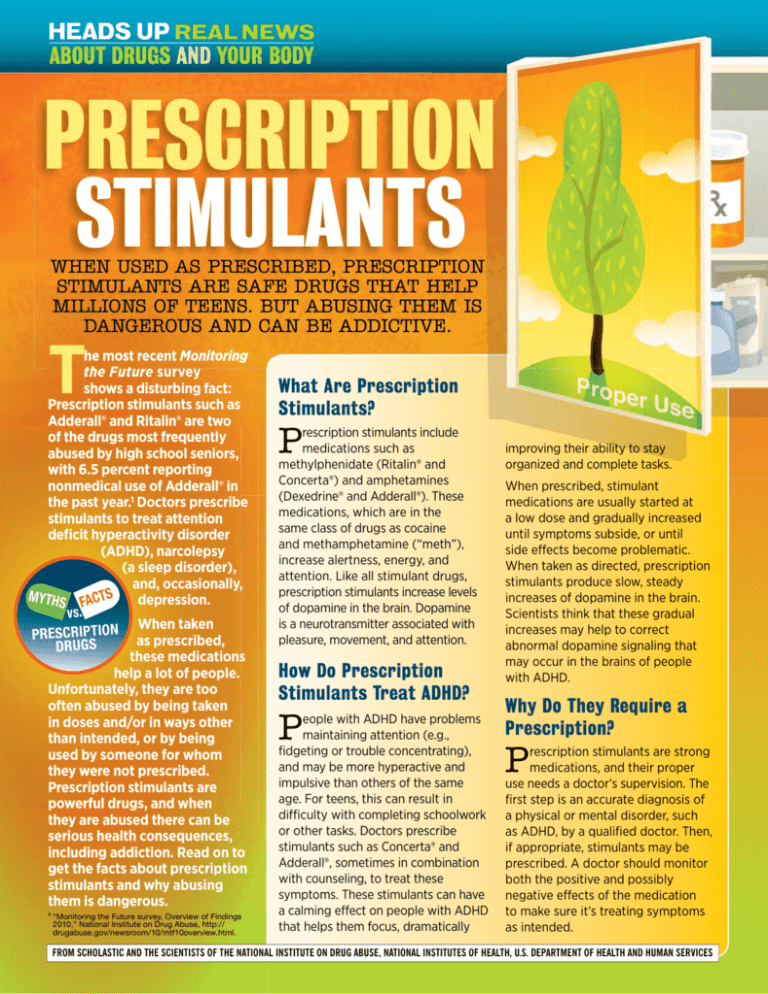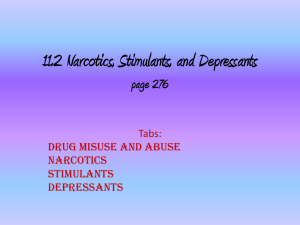
ABOUT DRUGS AND YOUR BODY
ABOUT DRUGS AND YOUR BODY
HEADS UP REAL NEWS
PRESCRIPTION
STIMULANTS
WHEN USED AS PRESCRIBED, PRESCRIPTION
STIMULANTS ARE SAFE DRUGS THAT HELP
MILLIONS OF TEENS. BUT ABUSING THEM IS
DANGEROUS AND CAN BE ADDICTIVE.
T
he most recent Monitoring
the Future survey
shows a disturbing fact:
Prescription stimulants such as
Adderall® and Ritalin® are two
of the drugs most frequently
abused by high school seniors,
with 6.5 percent reporting
nonmedical use of Adderall® in
the past year.1 Doctors prescribe
stimulants to treat attention
deficit hyperactivity disorder
(ADHD), narcolepsy
(a sleep disorder),
and, occasionally,
MYTHS FACTS
depression.
vs.
When taken
PRESCRIPTION as prescribed,
DRUGS
these medications
help a lot of people.
Unfortunately, they are too
often abused by being taken
in doses and/or in ways other
than intended, or by being
used by someone for whom
they were not prescribed.
Prescription stimulants are
powerful drugs, and when
they are abused there can be
serious health consequences,
including addiction. Read on to
get the facts about prescription
stimulants and why abusing
them is dangerous.
1
“Monitoring the Future survey, Overview of Findings
2010,” National Institute on Drug Abuse, http://
drugabuse.gov/newsroom/10/mtf10overview.html.
What Are Prescription
Stimulants?
P
rescription stimulants include
medications such as
methylphenidate (Ritalin® and
Concerta®) and amphetamines
(Dexedrine® and Adderall®). These
medications, which are in the
same class of drugs as cocaine
and methamphetamine (“meth”),
increase alertness, energy, and
attention. Like all stimulant drugs,
prescription stimulants increase levels
of dopamine in the brain. Dopamine
is a neurotransmitter associated with
pleasure, movement, and attention.
How Do Prescription
Stimulants Treat ADHD?
P
eople with ADHD have problems
maintaining attention (e.g.,
fidgeting or trouble concentrating),
and may be more hyperactive and
impulsive than others of the same
age. For teens, this can result in
difficulty with completing schoolwork
or other tasks. Doctors prescribe
stimulants such as Concerta® and
Adderall®, sometimes in combination
with counseling, to treat these
symptoms. These stimulants can have
a calming effect on people with ADHD
that helps them focus, dramatically
improving their ability to stay
organized and complete tasks.
When prescribed, stimulant
medications are usually started at
a low dose and gradually increased
until symptoms subside, or until
side effects become problematic.
When taken as directed, prescription
stimulants produce slow, steady
increases of dopamine in the brain.
Scientists think that these gradual
increases may help to correct
abnormal dopamine signaling that
may occur in the brains of people
with ADHD.
Why Do They Require a
Prescription?
P
rescription stimulants are strong
medications, and their proper
use needs a doctor’s supervision. The
first step is an accurate diagnosis of
a physical or mental disorder, such
as ADHD, by a qualified doctor. Then,
if appropriate, stimulants may be
prescribed. A doctor should monitor
both the positive and possibly
negative effects of the medication
to make sure it’s treating symptoms
as intended.
FROM SCHOLASTIC AND THE SCIENTISTS OF THE NATIONAL INSTITUTE ON DRUG ABUSE, NATIONAL INSTITUTES OF HEALTH, U.S. DEPARTMENT OF HEALTH AND HUMAN SERVICES
WWW.SCHOLASTIC.COM/HEADSUP
Prescription Stimulants and Cocaine Act
on the Same Parts of the Brain
The two brain scans below show how cocaine and methylphenidate
(Ritalin®) both act on the same dopamine sites in the brain. Dopamine
is a brain chemical associated with attention and pleasure.
Cocaine
Brain scan images from: Arch Gen Psychiatry 1995;52(6):456–463. Copyright © 2011 American Medical Association. All rights reserved.
You are abusing
prescription
stimulants if . . .
Why Are Prescription
Stimulants Abused?
M
any teens report abusing
prescription stimulants to get
high because they mistakenly believe
that prescription drugs are a “safer”
alternative to illicit drugs. Teens
also report abusing prescription
stimulants to try to lose weight or
increase wakefulness and attention.
Some even abuse them to get better
grades. Research, however, shows
that stimulant abuse is actually linked
to poorer academic performance.
Why? Because people who abuse
stimulants often take other drugs and
engage in behavior that puts their
academic performance at risk (e.g.,
skipping classes).
Is Abusing Prescription
Stimulants Dangerous?
Y
es. In fact, taking prescription
stimulants in high doses, or by
injection, smoking, or snorting, can
affect the brain in ways similar to
cocaine or other drugs of abuse (see
above right). Prescription stimulant
abuse can result in abnormally
Note: In this study, both drugs were
given intravenously to demonstrate
that they affect similar mechanisms
in the brain. However, when taken
orally, methylphenidate causes a
much slower increase in dopamine
levels, and does not create the same
euphoria experienced with cocaine.
Methylphenidate
Risks
. . . you take them
to cram for a test.
Stimulants can help you stay awake, but they can also
make you feel jittery, anxious, irritable, and even paranoid.
Stimulants may improve certain skills (e.g., focused
attention) at the expense of others (e.g., creative thinking).
There is no evidence that stimulants improve academic
performance in someone who does not have ADHD.
. . . you take them
to try to lose
weight.
Abusing stimulants can decrease appetite, which can lead to
weight loss and malnutrition. Plus, when a person stops taking
the stimulants, he or she usually gains the weight back, and
sometimes puts on a few more pounds. Thus, stimulants do
not provide a long-term weight-loss solution, and chronic use
increases the risk of addiction and other health consequences.
. . . you take them
to get high.
To get high on stimulants, people may take them in higher doses
than prescribed or by routes other than oral (e.g., snorted,
smoked, or injected). This practice increases the risk of serious
health consequences. High doses can cause blood vessels to
narrow, forcing the heart to work harder, and possibly lose its
normal rhythm. This could lead to a heart attack or a stroke.
high levels of dopamine, producing
euphoria, an intense feeling of
happiness. This increases the risk
for abusing again, and ultimately
for becoming addicted.
Abusing prescription stimulants
can also result in increased blood
pressure, heart rate, and body
temperature, as well as nausea,
headaches, anxiety, psychosis,
seizures, stroke, and heart failure.
Individuals who chronically abuse
prescription stimulants may
experience withdrawal symptoms
when they stop using them. These
symptoms can include fatigue,
depression, and disturbed sleep
patterns. Although not life
threatening, these symptoms often
prompt a return to drug use.
Important Resources
•
For more information on drugs,
go to http://teens.drugabuse.gov
or www.scholastic.com/headsup.
•
For immediate help with a crisis,
call 1–800–273–TALK.
•
To locate a treatment center,
call 1-800-662-HELP or visit
http://findtreatment.samhsa.gov.
FROM SCHOLASTIC AND THE SCIENTISTS OF THE NATIONAL INSTITUTE ON DRUG ABUSE, NATIONAL INSTITUTES OF HEALTH, U.S. DEPARTMENT OF HEALTH AND HUMAN SERVICES









